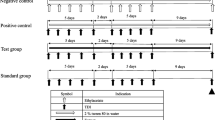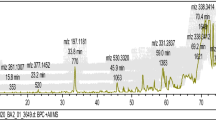Abstract
Lumnitzera racemosa a mangrove plant locally used to treat asthma, diabetes, herpes and hypertension. Present study was designed to investigate the anti-allergic and anti-hyperglycemic activities and also the responsible polyphenols for these potentials. Anti-allergic activity was evaluated on toluene 2,4-diisocyanate (TDI)-induced allergic model mice and anti-diabetic activity on streptozotocin (STZ)-induced diabetic mice. Natural polyphenolic compounds were determined by HPLC–DAD. In addition, in silico molecular docking was conducted via ‘Vina Wizard’ program in PyRx–Python Prescription 0.8 on nine isolated compounds against histamine H1 receptor (H1R) and sulfonylurea receptor 1 (SUR1). Acute toxicity study confirmed the safety of the leaves extract up to 3000 mg/kg dose in mice. Different biochemical parameters were also in normal at a dose of 500 mg/kg in sub-acute toxicity study. The leaves extract significantly suppressed (P < 0.05) TDI-induced allergy-like symptoms. The total and differential counts of WBC in blood and broncho alveolar lavage fluid (BALF) were also decreased in extract treated allergic mice. In STZ-induced diabetic mice, the extract significantly reduced the level of blood glucose and different related biomarkers. HPLC profiling revealed the presence of nine phenolic compounds; among these myricetin and rosmarinic acid demonstrated the best docking score − 8.4 kcal/mol against H1R whereas − 7.3 kcal/mol for standard drug cetirizine. On the other hand, rutin hydrate exhibited best docking score − 10.2 kcal/mol against SUR1, whereas standard drug glibenclamide showed − 8.4 kcal/mol. In conclusion, L. racemosa is safe and rich in different polyphenolic compounds which were found effective against allergy and diabetes.




Similar content being viewed by others
Abbreviations
- EELR:
-
Ethanolic extract of Lumnitzera racemosa
- TDI:
-
Toluene 2, 4-diisocyanate
- STZ:
-
Streptozotocin
- OECD:
-
Organization for economic co-operation and development
- H1R:
-
Histamine H1 receptor
- SUR1:
-
Sulfonylurea receptor 1
- SGOT:
-
Serum glutamic oxaloacetic transaminase
- SGPT:
-
Serum glutamic pyruvic transaminase
- ALP:
-
Alkaline phosphatase
- TG:
-
Triglyceride
- SEM:
-
Standard error of mean
- vs:
-
Versus
- RMSD:
-
Root-mean-square deviation
- UB:
-
Upper bound
- LB:
-
Lower bound
- PDB:
-
Protein data bank
References
Anjaneyulu AS, Murthy YL, Rao VL, Sreedhar K (2003) A new aromatic ester from the mangrove plant Lumnitzera racemosa willd. ARKIVOC 3:25–30
Paul T, Ramasubbu S (2017) The antioxidant, anticancer and anticoagulant activities of Acanthus ilicifolius L. roots and Lumnitzera racemosa Willd. leaves, from southeast coast of India. J Appl Pharm Sci 7(03):081–087. https://doi.org/10.7324/JAPS.2017.70313
Darwish AGG, Samy MN, Sugimoto S, Otsuka H, Abdel-Salam H, Matsunami K (2016) Effects of hepatoprotective compounds from the leaves of Lumnitzera racemosa on acetaminophen-induced liver damage in vitro. Chem Pharm Bull 64(4):360–365. https://doi.org/10.1248/cpb.c15-00830
White MV (1990) The role of histamine in allergic diseases. J Allergy Clin Immunol 86(4):599–605. https://doi.org/10.1016/S0091-6749(05)80223-4
Bakker RA, Wieland K, Timmerman H, Leurs R (2000) Constitutive activity of the histamine H1 receptor reveals inverse agonism of histamine H1 receptor antagonists. Eur J Pharmacol 387(1):R5–R7. https://doi.org/10.1016/S0014-2999(99)00803-1
Gengo FM, Gabos C (1987) Antihistamines, drowsiness, and psychomotor impairment: central nervous system effect of cetirizine. Ann Allergy 59(6 Pt 2):53–57
Takahashi H, Ishida-Yamamoto A, Iizuka H (2004) Effects of bepotastine, cetirizine, fexofenadine, and olopatadine on histamine-induced wheal-and flare-response, sedation, and psychomotor performance. J Clin Exp Dermatol 29(5):526–532. https://doi.org/10.1111/j.1365-2230.2004.01618.x
Siddharth N (2001) Containing the global epidemic of diabetes. J diabetol 3(11)
Dandona P, Ghanim H, Green K, Sia CL, Abuaysheh S, Kuhadiya N, Batra M, Dhindsa S, Chaudhuri A (2013) Insulin infusion suppresses while glucose infusion induces Toll-like receptors and high-mobility group-B1 protein expression in mononuclear cells of type 1 diabetes patients. Am J Physiol Endocrinol Metabol 304(8):810–818
Bnouham M, Ziyyat A, Mekhfi H, Tahri A, Legssyer A (2006) Medicinal plants with potential antidiabetic activity-a review of ten years of herbal medicine research (1990–2000). Int J Diabet Metabol 14(1):1. https://doi.org/10.1159/000497588
Mohan Y, Jesuthankaraj GN, Ramasamy Thangavelu N (2013) Antidiabetic and antioxidant properties of Triticum aestivum in streptozotocin-induced diabetic rats. Adv in pharmacol sci. https://doi.org/10.1155/2013/716073
Harborne A (1998) Phytochemical methods a guide to modern techniques of plant analysis. springer science & business media
Naidu JR, Ismail R, Sasidharan S (2014) Acute oral toxicity and brine shrimp lethality of methanol extract of Mentha Spicata L (Lamiaceae). Trop J Pharm Res 13(1):101–107. https://doi.org/10.4314/tjpr.v13i1.15
Chattopadhyay S, Ghosh S, Debnath J, Ghosh D (2001) Protection of sodium arsenite-induced ovarian toxicity by coadministration of L-ascorbate (vitamin C) in mature wistar strain rat. Arch Environ Contam Toxicol 41(1):83–89. https://doi.org/10.1007/s002440010223
Dev S, Mizuguchi H, Das AK, Maeyama K, Horinaga S, Kato S, Tamada M, Hattori M, Umehara H, Fukui H (2009) Kujin suppresses histamine signaling at the transcriptional level in toluene 2, 4-diisocyanate–sensitized rats. J Pharmacol Sci 109(4):606–617. https://doi.org/10.1254/jphs.09003
Sozmen SC, Karaman M, Micili SC, Isik S, Bagriyanik A, Ayyildiz ZA, Uzuner N, Anal O, Karaman O (2016) Effects of quercetin treatment on epithelium-derived cytokines and epithelial cell apoptosis in allergic airway inflammation mice model. Iran J Allergy Asthma Immunol 15(6):487
Hebi M, Khallouki F, Haidani A, Eddouks M (2018) Aqueous extract of Argania spinosa L. fruits ameliorates diabetes in streptozotocin-induced diabetic rats. Cardiovasc Hematol Agents Med Chem 16(1):56–65. https://doi.org/10.2174/1871525716666180103163107
Romani A, Minunni M, Mulinacci N, Pinelli P, Vincieri F, Del Carlo M, Mascini M (2000) Comparison among differential pulse voltammetry, amperometric biosensor, and HPLC/DAD analysis for polyphenol determination. J Agric Food Chem 48(4):1197–1203. https://doi.org/10.1021/jf990767e
Kim S, Chen J, Cheng T, Gindulyte A, He J, He S, Li Q, Shoemaker BA, Thiessen PA, Yu B (2019) PubChem 2019 update: improved access to chemical data. Nucleic Acids Res 47(D1):D1102–D1109. https://doi.org/10.1093/nar/gky1033
Berman HM, Westbrook J, Feng Z, Gilliland G, Bhat TN, Weissig H, Shindyalov IN, Bourne PE (2000) The protein data bank. Nucleic Acids Res 28(1):235–242. https://doi.org/10.1093/nar/28.1.235
Dallakyan S, Olson A (2015) Small-molecule library screening by docking with pyrx. In: Chemical Biology: Methods Protocols. Humana Press, New York. https://doi.org/10.1007/978-1-4939-2269-7_19
Dasgupta R, Saha I, Pal S, Bhattacharyya A, Sa G, Nag TC, Das T, Maiti B (2006) Immunosuppression, hepatotoxicity and depression of antioxidant status by arecoline in albino mice. Toxicology 227(1–2):94–104. https://doi.org/10.1016/j.tox.2006.07.016
Iriyoshi N, Takeuchi K, Yuta A, Ukai K, Sakakura Y (1996) Increased expression of histamine H1 receptor mRNA in allergic rhinitis. Clin Exp Allergy 26(4):379–385. https://doi.org/10.1111/j.1365-2222.1996.tb00553.x
Mahajan SG, Mali RG, Mehta AA (2007) Effect of Moringa oleifera Lam. seed extract on toluene diisocyanate-induced immune-mediated inflammatory responses in rats. J Immunotoxicol 4(2):85–96. https://doi.org/10.1080/15476910701337472
Winther L, Reimert C, Skov P, Kærgaard Poulsen L, Moseholm L (1999) Basophil histamine release, IgE, eosinophil counts, ECP, and EPX are related to the severity of symptoms in seasonal allergic rhinitis. Allergy 54(5):436–445. https://doi.org/10.1034/j.1398-9995.1999.00910.x
Norzila M, Fakes K, Henry RL, Simpson J, Gibson PG (2000) Interleukin-8 secretion and neutrophil recruitment accompanies induced sputum eosinophil activation in children with acute asthma. Am J Respir Crit 161(3):769–774. https://doi.org/10.1164/ajrccm.161.3.9809071
Kirby JG, Hargreave FE, Gleich GJ, O'byrne PM (1987) Bronchoalveolar cell profiles of asthmatic and nonasthmatic subjects. Am Rev Respir Dis 136(2):379–383. https://doi.org/10.1164/ajrccm/136.2.379
Chakrabarty B, Acharyya RN, Kundu N, Mahmud I, Hossain H, Biswas NN, Uddin SJ, Dev S, Das AK (2020) Evaluation of anti-diabetic and anti-allergic activities of brownlowia tersa (L.) kosterm leaves extract and determination of its phenolic compounds by HPLC-DAD. Trop J Nat Prod Res 4(8):326-333. https://doi.org/10.26538/tjnpr/v4i8.1
Cheatham WW, Boss AH (2011) Superior control of blood glucose in diabetes treatment. International Patent Classification(s) : A61K 38/28(2006.01)
Al-Attar AM, Alsalmi FA (2019) Effect of Olea europaea leaves extract on streptozotocin induced diabetes in male albino rats. Saudi J Biol Sci 26(1):118–128. https://doi.org/10.1016/j.sjbs.2017.03.002
Acknowledgements
The authors are grateful to the Department of Pharmacy, Jahangirnagar University, Savar, Dhaka, Bangladesh, for providing experimental mice. The authors would like to express their heartiest thanks and gratitude to Chemical Research Division, BCSIR Laboratories, Dhaka, Bangladesh, for helping in HPLC analysis.
Funding
The work was supported by the Khulna University Research cell, Khulna-9208, Bangladesh (Grant Number: KURC- 04/2000-69).
Author information
Authors and Affiliations
Contributions
The submitted research work was conducted in collaboration among the authors. The project was designed by AKD (Asish Kumar Das) and SD (Shrabanti Dev). SM (Shuvra Mithla) and RNA (Rabindra Nath Acharyya) conducted the detail literature review and performed the phytochemical screening. SM, SR (Suborna Rani) and RNA have performed the extraction, acute and sub-acute toxicity study, anti-allergic and anti-hyperglycemic activity study. HPLC analysis was performed by KSA (Khondoker Shahin Ahmed) and HH (Hemayet Hossain). SD carried out the statistical analysis. Article writing and in silico molecular docking were done by MAI (Md. Arman Islam), RNA and MG (Mimi Golder). Critical revision of the article was done by SD and AKD. All authors have read and approved the final manuscript.
Corresponding author
Ethics declarations
Conflict of interest
The authors declared that they have no conflict of interest.
Ethical Approval
Animal Ethics Committee, Life Science School, Khulna University, Khulna-9208, Bangladesh, approved all experiments using mice (KU/PHARM/AEC/15/06/31).
Additional information
Publisher's Note
Springer Nature remains neutral with regard to jurisdictional claims in published maps and institutional affiliations.
Significance Statement This study ensured the safety as well as anti-allergic and anti-diabetic potentials of L. racemosa leaves extract and also revealed that myricetin, rosmarinic acid and rutin hydrate might be the lead compounds for these therapeutic activities.
Rights and permissions
About this article
Cite this article
Acharyya, R.N., Mithila, S., Rani, S. et al. Anti-allergic and Anti-hyperglycemic Potentials of Lumnitzera racemose Leaves: In vivo and In silico Studies. Proc. Natl. Acad. Sci., India, Sect. B Biol. Sci. 93, 147–158 (2023). https://doi.org/10.1007/s40011-022-01399-3
Received:
Revised:
Accepted:
Published:
Issue Date:
DOI: https://doi.org/10.1007/s40011-022-01399-3




